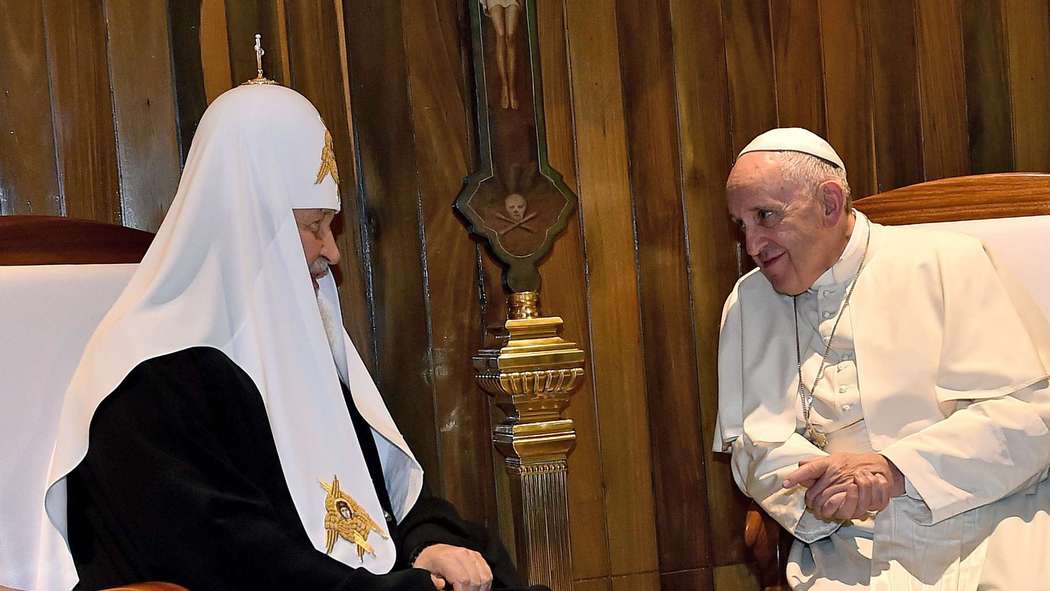Patriarch Kirill with Pope Francis
After almost a thousand years that have failed to bring about any meeting between the head of the Catholic Church and the head of Russian Orthodox Chu
Mar 04, 2016

By Fr Rif’at Bader
After almost a thousand years that have failed to bring about any meeting between the head of the Catholic Church and the head of Russian Orthodox Church, a plane heading from the Vatican, and another one heading from Moscow, touched down in Cuba to pave the way for a meeting between the leaders of the two Churches, namely Pope Francis and Patriarch Kirill. The Cuban island has become one of the symbols of global reconciliation. After the reconciliation attained with the United States last year, Cuba hosted a “reconciliation” meeting between the two Churches which serves as a positive significance that paves the way for a new millennium of brotherhood.
In 1054, the East-West schism took place. Constantinople named itself the second Rome and Moscow named itself the third Rome. Today, the state of peace and reconciliation prevails among “the leaders” who restore the status quo ante of being “brothers.” The Pope had met with Patriarch of Constantinople, Bartholomew, named the ecumenical patriarch in the Vatican, in Jerusalem and in Istanbul. Two years ago, he met with Patriarch of Coptic Orthodox, Pope Tawadros, who had visited the Vatican. He, consequently, meets with the Russian patriarch to lay the groundwork for a state of collective procession towards unity.
It is worthy to note, in this regard, that the first millennium has been the millennium of harmony, for there is a common tradition recognized by all the Churches. Furthermore, there are common teachings which are hoped to be reactivated in the days to come, following years of estrangement, as well as of tense and frozen relations.
The Cuba meeting, which included a hug between “the two brothers” and the signing of an important 30-point statement, focused on the need to instil cordiality in the world of today. It also stressed that the mutual points relevant to concord are much greater than the doctrinal differences or, rather, those triggering disputes.
The document neither touches on any doctrinal issue nor on the causes that led to the schism. It, rather, called for focusing on the common denominators which would consolidate the spirit of brotherhood rather than “the spirit of competitiveness” which prevails among the various religious components. The document touched on issues relevant to justice and peace in the world, and called for the need to cement solidarity among the various Churches, as well as among the various religions, in an atmosphere of respect for religious freedoms for every person as well as for every “religious group.”
The two leaders signed, in the presence of the Cuban president, points relevant to the prevailing conflicts in the Middle East. It is regrettable that it did not mention the Holy Land and the Palestinian- Israeli dispute, as the statement merely addressed the situation in both Iraq and Syria. The statement explicitly noted: “No crime may be committed in God’s name, for He is the God of peace.” On interreligious dialogue, the two leaders said: “It is indispensable in our disturbing times. Differences in the understanding of religious truths must not impede people of different faiths to live in peace and harmony.” The document also touched on the current persecution of Christians of the Middle East and called for preserving the historic Christian presence in this holy spot of the world. It also called for the release of all the detained kidnapped, particularly the Metropolitans of Aleppo, Bishops Yohanna Ibrahim and Boulos Yazigi who had been kidnapped three years ago, where nothing has transpired about their fate.
The document underlined the value of family within the framework of marriage between man and woman, and rejected all forms of new “marriage”, especially after having some countries consider same-sex marriages as a form of legal family. It also condemned miscarriage and euthanasia because human dignity is sacred at all stages of life.
Furthermore, the Cuba Declaration between the two Churches is a new prelude for Christian unity which is increasingly an exigent target. Despite the fact that the road to attain the target is still long, yet the first step in this direction is merely taking a route in the right direction. The Pope and the Patriarch said: “This is possible and necessary.” We are awaiting a second and a third summit in both the Vatican and Moscow.
Source: Vatican Insider
--The original article was published on the abouna.org website and appears here with permission







Total Comments:0